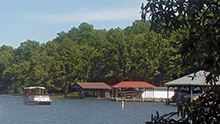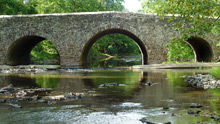Goniobasis nassula or "Elimia" nassula
> Habitat & Distribution
Pleurocera nassula is among the most obscure and enigmatic of all the North American pleurocerids. The species was originally described from the Big Spring in Tuscumbia, Alabama. Goodrich (1940) gave its range as springs and spring branches of Madison and Colbert counties, Alabama but we are not aware of any modern North Alabama records beyond the type locality. We have, however, recently discovered a population of P. nassula inhabiting a small tributary of the Red/Cumberland north of Clarksville, TN. Pleurocera nassula is rare in our 17-state study region, FWGNA incidence rank I-2.
> Ecology & Life History
Grazing by populations of pleurocerids can have a significant effect on energy flow in small streams (Dillon 2000: 86 - 91, see also Dillon & Davis 1991).
Like other pleurocerids, P. nassula is dioecious, eggs being deposited on hard substrates from spring to mid-summer. Eggs are spirally arranged in masses of 2-15 or more, with a tough, membranous outer covering to which sand grains typically adhere (Smith 1980, Jokinen 1992). Although we are unaware of any study specifically directed toward the life history of P. modesta, it seems reasonable to expect that two years will be required for maturity, and that several years of iteroparous reproduction can be expected thereafter, as is the case for pleurocerids generally (Dazo 1965). This is life cycle Hi of Dillon (2000: 156 - 162).
> Taxonomy & Systematics
"Melania" nassula was described by T. A. Conrad in 1834 from the limestone spring at Tuscumbia, Ala. Tryon (1873) transferred it to Goniobasis and synonymized underneath it Lea s (1841) Melania edgariana, a wide-ranging species found throughout Middle Tennessee. Goodrich (1930, 1940) pulled Goniobasis edgariana back out to specific status, leaving the only known populations of G. nassula the Tuscumbia type locality, the main Tennessee River in the vicinity of Tuscumbia, and Graham Spring at Huntsville. This last locality was probably Brahan Spring, now impounded.
Lea (1862) also described a Goniobasis crispa from "Florence, Alabama" that Goodrich (1940) considered a subspecies of G. perstriata. This seems to be a population (or possibly a single individual) of P. nassula, washed down from Tuscumbia into the Tennessee River.
Goodrich (1930) noted the impression given by the sculpture of the shell that the species belongs to the group of Goniobasis catenaria (Say). We agree. Our first impression, upon sampling the type locality, was that a population of Atlantic-drainage P. catenaria catenaria had been transported 500 km west by helicopter and dropped in the middle of Tuscumbia.
This species has travelled through three genera in thirty years. Although predominantly assigned to Goniobasis through most of the 20th century, in the 1980s many workers began placing it in the resurrected generic nomen, "Elimia." Both Goniobasis and Elimia were subsumed under Pleurocera by Dillon (2011). See my essay of 23Mar11 from the link below for more.
> Maps and Supplementary Resources
> Essays
- Taxonomic controversy has surrounded the generic nomina Pleurocera, Goniobasis, and Elimia for many years. The best entry into the subject would be my essay of 23Mar11, entitled Goodbye Goniobasis, Farewell Elimia. Links are available from that essay to older resources.
- Pleurocera crispa (aka nassula) made a guest appearance in my lengthy essay of 10May20 (A House Divided). Quoting from that essay, "No, Goniobasis crispa is not a subspecies of perstriata, nor is it a synonym of troostiana, nor is it related to any other species we have treated this month, or at any time in recent memory. Goniobasis crispa (Lea 1862) is entirely different. And to quote my favorite Alabamian, "That's all I've got to say about that."
- Pleurocera nassula also made guest appearances in my lengthy essay of 5June20 (What is Melania edgariana?). Quoting that essay verbatim, "I feel sure we will come back to Tuscumbia in some future post. But for now, we will stipulate that Lea s edgariana and Conrad s nassula are two entirely different things, and that s all I ve got to say about that."
- I ultimately "had more to say" about Pleurocera crispa being a junior synonym of P. nassula in my review of 10Dec24, Taxonomy Part 1. That essay featured an image of Lea's (1862) holotype.
- And I returned to Tuscumbia, and had more to say about P. nassula, in my review of [coming soon], Taxonomy Part 2. See that essay for a reproduction of Conrad's original (1834) figure and a fresh image of an MCZ syntype.
> References
Conrad, T. A. (1834) New
Fresh Water Shells of the United States, with coloured illustrations,
and a monograph of the genus Anculotus of Say; also A synopsis of the
American naiades. Philadelphia, Judah Dobson. 76
pp, 8
plates.
Dazo, B. C.
(1965) The morphology and natural history of Pleurocera acuta
and Goniobasis livescens
(Gastropoda: Cerithiacea: Pleuroceridae). Malacologia 3: 1 -
80.
Dillon, R. T., Jr. (2000)
The Ecology of Freshwater Molluscs. Cambridge, Cambridge University
Press. 509 pp.
Dillon, R. T., Jr. (2011)
Robust shell phenotype is a local response to stream size in the genus Pleurocera
(Rafinesque, 1818). Malacologia 53: 265-277.
Dillon, R. T. Jr.,
& K. B. Davis (1991) The diatoms
ingested by freshwater snails: temporal, spatial, and interspecific
variation. Hydrobiologia 210: 233-242.
Dillon, R.T., Jr.
& Robinson, J.D. (2009)
The snails the dinosaurs saw: Are the pleurocerid populations of the
Older Appalachians a relict of the Paleozoic Era? J. N. Am.
Benthol. Soc. 28: 1-11.
Goodrich, C. (1930)
Goniobases of the vicinity of Muscle Shoals.
Occasional
Papers of the Museum of Zoology, University of Michigan 209: 1 - 25.
Goodrich, C. (1940)
The Pleuroceridae of the Ohio River drainage system. Occas.
Pprs. Mus. Zool. Univ. Mich., 417: 1-21.
Goodrich, C. (1941)
Pleuroceridae of the small streams of the Alabama River
system. Occas. Pprs. Mus. Zool. Univ. Mich., 427: 1-10.
Jokinen, E.H. (1992)
The freshwater snails of New York State. New York State Museum
Biological Survey, New York State Museum Bulletin 482.
Lea, Isaac (1841)
Continuation of Mr. Lea's paper on New Fresh Water and Land
Shells. Proceedings o the American Philosophical Society 2:
11
15.
Lea, Isaac (1843)
Description of New Fresh Water and Land Shells. Transactions of
the American Philosophical Society (New Series) 8: 163 250.
Lea, Isaac (1862) Description of a new genus (Goniobasis)
of the Family Melanidae and eighty-two new species. Proceedings of the
Academy of Natural Science of Philadelphia 19: 262 272.
Smith, D.G.
(1980) Goniobasis
virginica (Gastropoda: Pleuroceridae) in the Connecticut
River USA. Nautilus 94:50-54.
Tryon, G. W.
(1873) Land and Freshwater shells of North
America Part IV, Strepomatidae. Smithsonian Miscellaneous
Collections 253: 1 - 435.








